The Dumbbell Nebula is a planetary nebula located approximately 1,360 light-years away in the northern constellation Vulpecula (the Fox). With an apparent magnitude of 7.4, it is one of the largest and brightest planetary nebulae in the sky. It is listed as Messier 27 (M27) in the Messier catalogue and NGC 6853 in the New General Catalogue.
The Dumbbell Nebula is a popular target among amateur astronomers. It can be seen in binoculars and small telescopes near the constellation figure of Sagitta (the Arrow).
The nebula was named for its resemblance to a dumbbell when observed in visible light. It is also known as the Apple Core Nebula or Diabolo Nebula. When seen from Earth, M27 appears along the plane of its equator and has the shape of a prolate spheroid.
The Dumbbell Nebula is one of the finest and brightest objects of its kind. With an apparent diameter of 8 by 5.6 arcminutes, it is one of the largest planetary nebulae in the sky. Its main luminous body has an angular diameter of almost 6 arcminutes and its halo stretches out to more than 15 arcminutes, which is half the size of the full Moon.
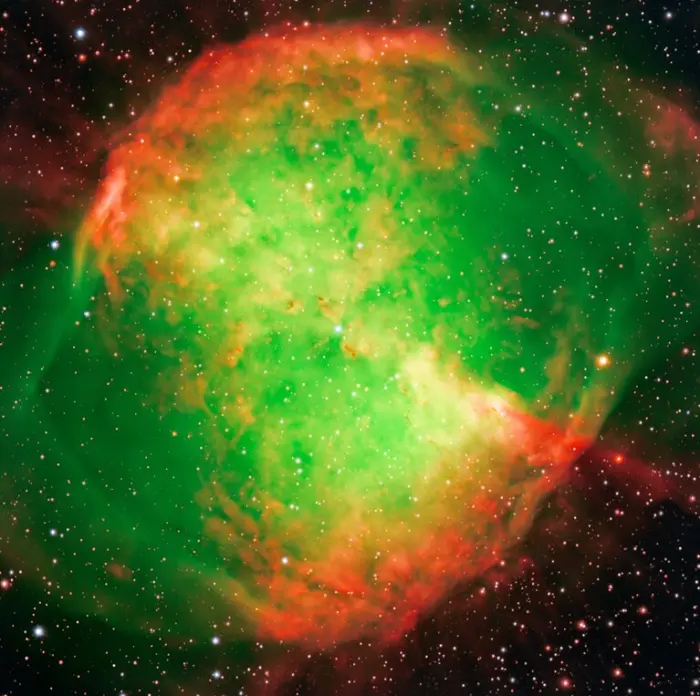
The Dumbbell Nebula — also known as Messier 27 or NGC 6853 — is a typical planetary nebula and is located in the constellation Vulpecula (the Fox). The distance is rather uncertain, but is believed to be around 1,200 light-years. It was first described by the French astronomer and comet hunter Charles Messier who found it in 1764 and included it as no. 27 in his famous list of extended sky objects. Despite its class, the Dumbbell Nebula has nothing to do with planets. It consists of very rarified gas that has been ejected from the hot central star (well visible on this photo), now in one of the last evolutionary stages. The gas atoms in the nebula are excited (heated) by the intense ultraviolet radiation from this star and emit strongly at specific wavelengths. Image credit: ESO/I. Appenzeller, W. Seifert, O. Stahl, M. Zamani (CC BY 4.0)
With a diameter of 15’ at its faintest extensions, the Dumbbell Nebula is the second largest planetary nebula known. It is only smaller in size than the Helix Nebula (NGC 7293) in the constellation Aquarius. However, the Helix has a lower surface brightness, which makes the Dumbbell much easier to observe.
Like other planetary nebulae, the Dumbbell Nebula is an expanding shell of gas ejected by a star that had used up all its nuclear fuel. The cloud of gas is illuminated by the exceptionally hot remnant core of the central star.
Planetary nebulae are remnants of stars similar to our Sun. When they reach the end of their life cycles as evolved red giants, these stars expel their outer gaseous layers to form a nebula, which is then heated by the hot core of the stellar remnant. This will be the fate of our Sun in roughly five billion years.
Planetary nebulae were named for their resemblance to the gas giants of the solar system. They appear as small diffuse objects, not unlike the outer planets, when observed in a small telescope.
The gas ejected by the progenitor star in M27 is blocked from expanding sideways by a circumstellar disk. As a result, the gas forms two bubbles, one above and one below the disk’s plane.
In 1992, Moreno-Corral et al. found an angular expansion rate of 2.3 arcseconds per century for M27. This corresponds to an age of up to 14,600 years. However, in 1970, Bohuski, Smith and Weedman determined an expansion velocity of 31 km/s. With a semi-minor radius of 1.01 light-years, this corresponds to a kinematic age of 9,800 years.
Other measurements indicate that the nebula’s bright portion is expanding at a rate of 6.8 arcseconds per century, which would put the nebula’s age between 3,000 and 4,000 years.
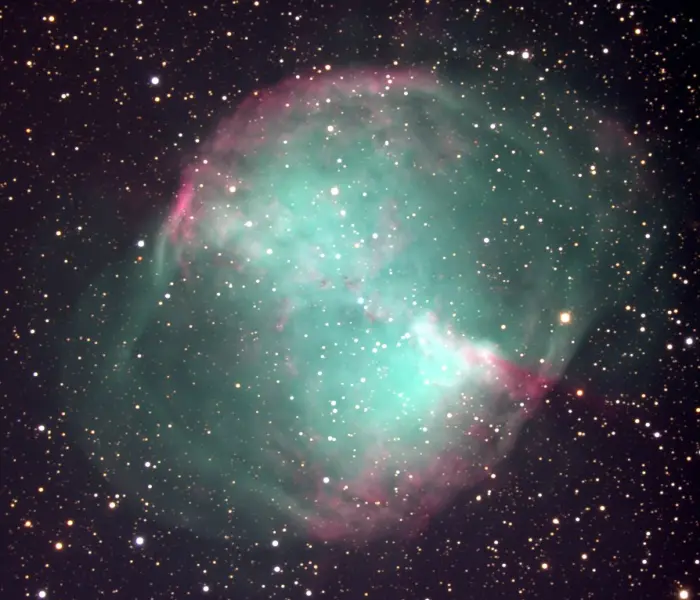
The Dumbbell Nebula, Messier object 27 (M27), NGC6853, in the constellation Vulpecula. This approximately true-color image has been stretched in dynamic range to reveal the fainter outer regions along with the more usual bright inner regions. It is interesting to compare this picture with an older true-color picture, and an emission-line image, and a deep near-infrared image. This image was taken in July 2000 at the Kitt Peak 2.1-meter telescope, during the Research Experiences for Undergraduates (REU) program operated at the Kitt Peak National Observatory and supported by the National Science Foundation. Image credit: REU program/NOIRLab/NSF/AURA (CC BY 4.0)
The central star of the Dumbbell Nebula is one of the largest white dwarfs known. It has an estimated radius of 0.055 ± 0.02 solar radii, or 0.13 light seconds, which indicates that the star is still above the white dwarf cooling track. In 1999, a team led by Napiwotzki determined a mass of 0.56 ± 0.01 solar masses and an absolute magnitude of 5.48 for the star.
The central star in the Dumbbell Nebula has a visual magnitude of 13.8 and a surface temperature of about 85,000 K. It has the stellar classification DAO. The star may have a faint, magnitude 17 yellow companion. If it exists, the companion has an absolute magnitude of about 9 – 9.5.
Like other planetary nebulae, M27 contains a pattern of dark and bright knots in its central region. The dense knots of gas and dust and their dark tails vary in size and appearance. Their shapes change as the nebula expands. Some look like fingers pointing at the central star, while others appear as isolated clouds. The size of the knots is in the range from 17 billion to 56 billion kilometres, or several times the distance from the Sun to Pluto. Each knot has a mass about three times that of the Earth.
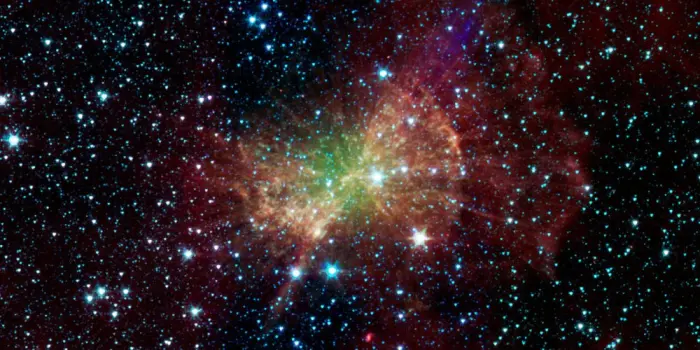
The Dumbbell Nebula, also known as Messier 27, pumps out infrared light in this image from NASA’s Spitzer Space Telescope. Spitzer’s infrared view shows a different side of this recycled stellar material. It is interesting how different Spitzer’s view of the Dumbbell looks compared to optical images, comments Dr. Joseph Hora of the Harvard Smithsonian Center for Astrophysics. The diffuse green glow, which is brightest near the center, is probably showing us hot gas atoms being heated by the ultraviolet light from the central white dwarf. A collection of clumps fill the central part of the nebula, and red-coloured radial spokes extend well beyond. Astronomers think these features represent molecules of hydrogen gas, mixed with traces of heavier elements. Image: NASA/JPL-Caltech/J. Hora (Harvard-Smithsonian CfA)
The knots form at points where the ionized hot portions of the nebula meet the neutral cool regions. The area where the different temperatures meet is gradually moving away from the central star as the nebula evolves.
The heads of the knots contain bright cusps, which are photoionization fronts. They appear similar to those seen in the Helix Nebula (NGC 7293) in Aquarius and the Clown Face Nebula (NGC 2392) in Gemini. The knots are also visible in Hubble images of the Ring Nebula in Lyra and the Retina Nebula in Lupus.
Knots in planetary nebulae are produced when the stellar winds from the central stars are not powerful enough to blow away larger clumps of material. Instead, they blow away smaller fragments, which form trails behind the clumps.
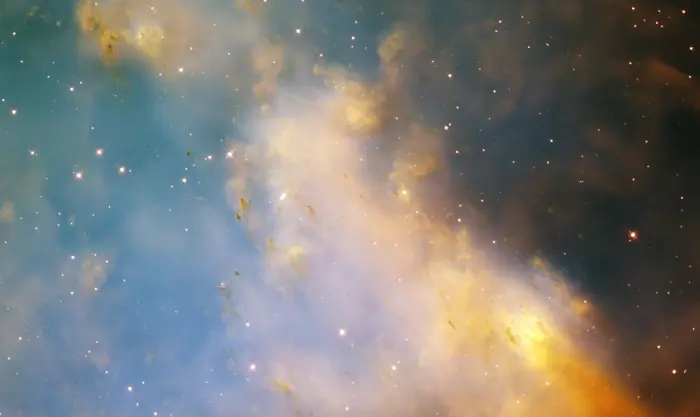
An aging star’s last hurrah is creating a flurry of glowing knots of gas that appear to be streaking through space in this close-up image of the Dumbbell Nebula, taken with NASA’s Hubble Space Telescope. The Dumbbell, a nearby planetary nebula residing more than 1,200 light-years away, is the result of an old star that has shed its outer layers in a glowing display of color. The Hubble images of the Dumbbell show many knots, but their shapes vary. The knots are forming at the interface between the hot (ionized) and cool (neutral) portion of the nebula. This area of temperature differentiation moves outward from the central star as the nebula evolves. In the Dumbbell astronomers are seeing the knots soon after this hot gas passed by. Dense knots of gas and dust seem to be a natural part of the evolution of planetary nebulae. This image, created by the Hubble Heritage Team (STScI), was taken by Hubble’s Wide Field Planetary Camera 2 in November 2001, by Bob O’Dell (Vanderbilt University) and collaborators. The filters used to create this color image show oxygen in blue, hydrogen in green and a combination of sulfur and nitrogen emission in red., image credit: C.R. O’Dell (Vanderbilt University)
Facts
The Dumbbell Nebula was the first planetary nebula to be discovered. French astronomer and comet hunter Charles Messier discovered it on July 12, 1764, and included it as the 27th object in his catalogue. He didn’t know at the time that M27 was the first planetary nebula to be discovered. He described it as an oval nebula without stars.
In his original entry, Messier wrote, “Nebula without star, discovered in Vulpecula, between the two forepaws, and very near the star 14 of that constellation, of 5th magnitude according to Flamsteed; one can see it well with an simple refractor of 3.5 feet; it appears of oval shape, and it contains no star.”
The Dumbbell Nebula is one of only four planetary nebulae included in the Messier catalogue. The other three are Messier 57 (the Ring Nebula) in Lyra, Messier 76 (the Little Dumbbell Nebula) in Perseus, and Messier 97 (the Owl Nebula) in Ursa Major.
William Herschel was the first to designate M27 as a planetary nebula, around 1784. The nebula’s appearance in a telescope was similar to that of the newly discovered Uranus.
His son John Herschel is credited for naming the nebula Dumbbell. The younger Herschel observed the nebula in August 1828 and, in 1833, he described it as a “nebula shaped like a dumb-bell, with the elliptic outline completed by a feeble nebulous light.”
When observed from Earth, Messier 27 appears along its equatorial plane, much like the Little Dumbbell Nebula (M76) in Perseus constellation. The Little Dumbbell was named for its resemblance to M27. If we could see the Dumbbell Nebula from the side, it would likely appear similar to the Ring Nebula (Messier 57) in the Lyra constellation.
A variable star, nicknamed the Goldilocks Variable, was discovered in the outer regions of the Dumbbell Nebula in 1988. It was first spotted by Czech amateur astronomer Leos Ondra, who compared different images of M27 and found that the star appeared in some of them, but not in others. Ondra concluded that the star was a long period variable. The star was later classified as a Mira variable, an evolved star that varies in brightness due to pulsations. It appears in the same line of sight as the Dumbbell but in fact lies much further away.
Location
The Dumbbell Nebula is relatively easy to find because it appears in the region of the Summer Triangle. Even though it lies in the faint Vulpecula, it is surrounded by several distinctive constellation figures. It appears along the line extended from Albireo (Beta Cygni), the star at the base of the Northern Cross in Cygnus, to Rotanev (Beta Delphini), the brightest star in the constellation Delphinus.
The nebula lies near the recognizable constellation figure of Sagitta (the Arrow). It appears almost directly north of the red giant Gamma Sagittae, the star that marks the tip of the Arrow, and just south of the faintly visible 14 Vulpeculae.
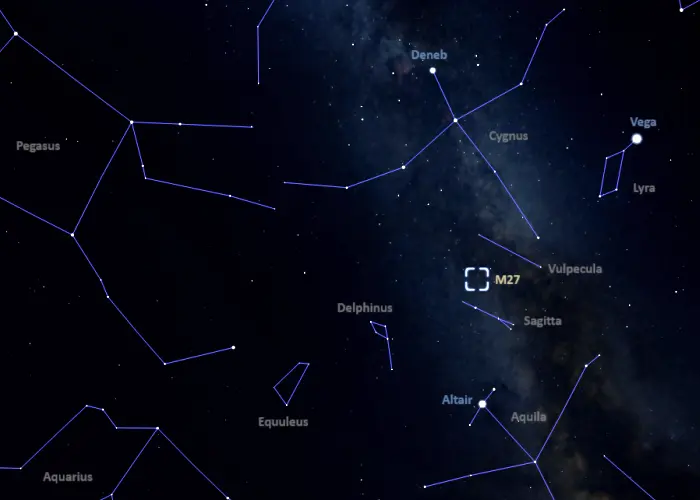
Dumbbbell Nebula location, image: Stellarium
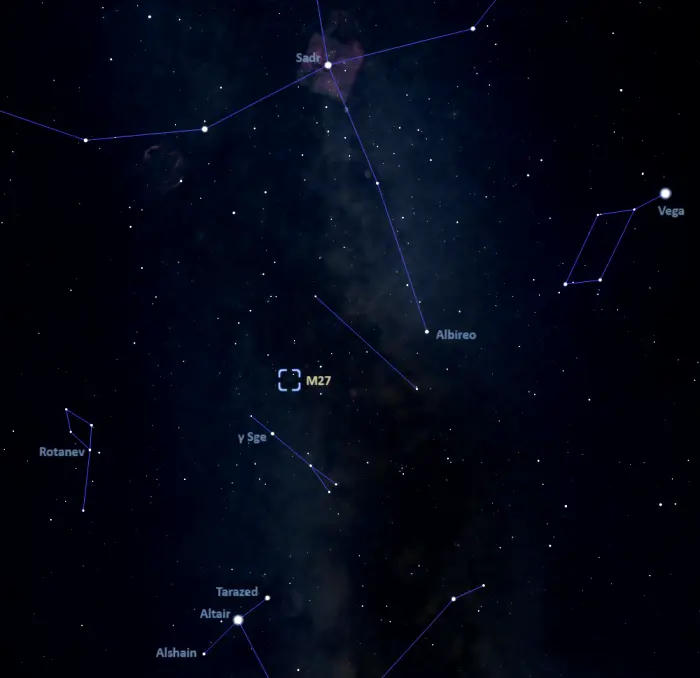
Messier 27 location, image: Stellarium
Alternatively, the Dumbbell Nebula can be found about two fifths of the way from Tarazed (Gamma Aquilae) to Sadr (Gamma Cygni). Tarazed is the brighter of the two stars flanking Altair in the constellation Aquila and Sadr is the central star of the Northern Cross, the asterism that dominates the constellation Cygnus.
The open cluster NGC 6830 appears about 2 degrees west of the nebula. The cluster lies approximately 6,000 light-years away.
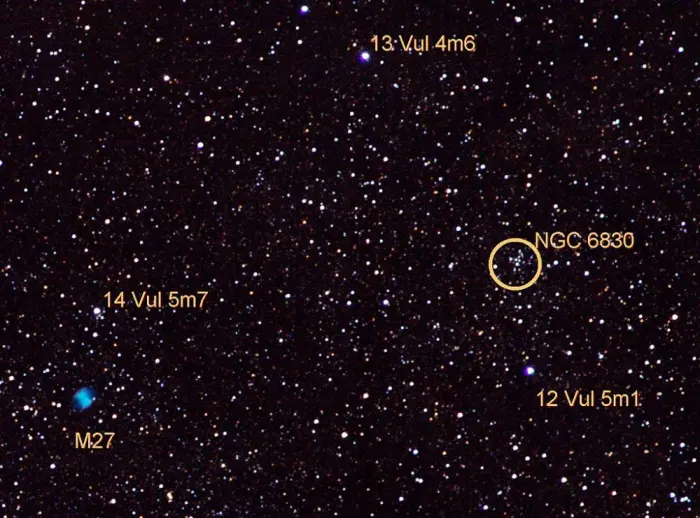
Area of the sky around M27 and including NGC 6830. Image: Trinitrix at wikipedia.org (CC BY-SA 3.0)
The Dumbbell Nebula can be seen in 10×50 binoculars, but it appears only as a small oval patch of light. It appears much brighter and larger in 15×70 binoculars. Its central region can easily be made out from the dimmer outer regions in small telescopes.
The Dumbbell Nebula’s recognizable hourglass shape can be seen in 80 mm (3.1-inch) telescopes, and the surface details are visible in larger telescopes. The nebula is particularly good to look at through a 200 mm (8-inch telescope) using a filter.
The best time of the year to observe the Dumbbell Nebula is during the month of September, when the constellation Vulpecula climbs high above the horizon in the evening. At declination +22° 43, the Dumbbell is visible from locations north of the latitude 67° S, i.e. from most places on Earth.
Dumbbell Nebula – Messier 27
| Constellation | Vulpecula |
| Right ascension | 19h 59m 36.3631850088s |
| Declination | +22° 43′ 16.312059552″ |
| Apparent magnitude | 7.4 |
| Apparent size | 8.0′ × 5.6′ |
| Absolute magnitude | -0.6 (-0.9 to -0.2) |
| Distance | 1,360 light-years (417 parsecs) |
| Radius | 1.44 light-years (1.28 – 1.65 ly) |
| Names and designations | Dumbbell Nebula, Messier 27, M27, NGC 6853, Apple Core Nebula, Diabolo Nebula, Hen 2-452, PN G060.8-03.6, VV’ 521, VV 246, ARO 14, PK 060-03 1, 2E 4308, BD+22 3878, GCRV 12336, EUVE J1959+22.7, PLX 4735.00, IRAS 19574+2234, 2MASX J19593637+2243157, WD 1957+225, Gaia DR2 1827256624493300096, Gaia DR3 1827256624493300096 |
Images
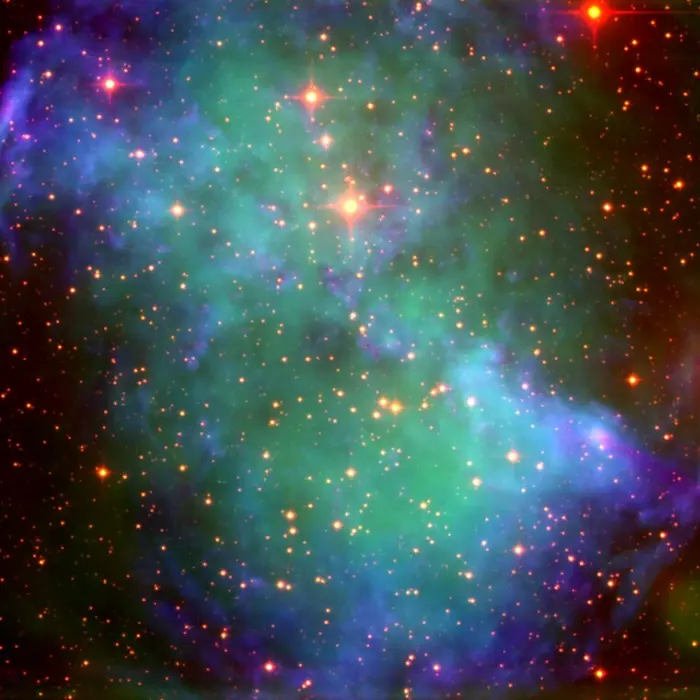
This false-color image of the Dumbbell Nebula M27, or NGC 6853, was taken by the 3.5-meter WIYN telescope using a new 2k x 2k high resistivity, thick, p-channel CCD manufactured by the Lawrence Berkeley National Laboratories. These CCDs have excellent quantum efficiency at red wavelengths, and are currently being tested by NOAO (for further details, see the September 2001 NOAO Newsletter, currently only available in PDF format). The picture was created from images taken through narrow-band filters centered roughly on the H-alpha (blue) and the [SIII] 9532A emission lines (green), and an intermediate band filter centered at 1.02 microns which includes emission from HeII at 10124 A (red). Image credit: Nigel Sharp, Rich Reed, Dave Dryden, Dave Mills, Doug Williams, Charles Corson, Roger Lynds and Arjun Dey/NOAO/WIYN/NSF (CC BY 4.0)
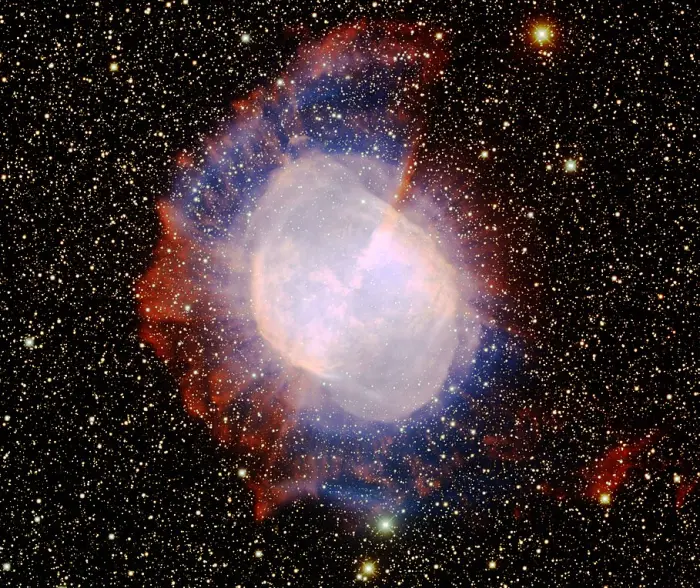
This image was obtained with the wide-field view of the Mosaic camera on the Mayall 4-meter telescope at Kitt Peak National Observatory. M27, also known as the ‘Dumbbell Nebula’, is a famous planetary nebula. The central portion of the nebula is quite bright, however it also has a faint outer halo that is clearly visible in this deep image. The image was generated with observations in the Oxygen [OIII] (blue), Hydrogen-Alpha (red) and Sulphur [SII] (green) filters. In this image, North is left, East is down. Image credit: T.A. Rector (University of Alaska Anchorage) and H. Schweiker (WIYN and NOIRLab/NSF/AURA) (CC BY 4.0)
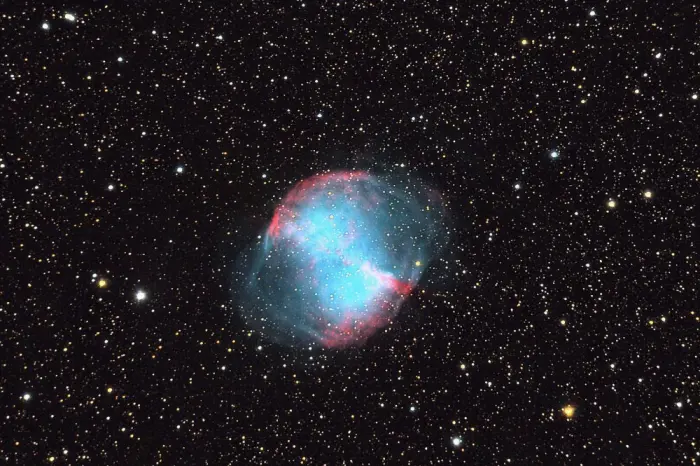
The Dumbbell Nebula (Messier 27), image: Fryns at wikipedia.org
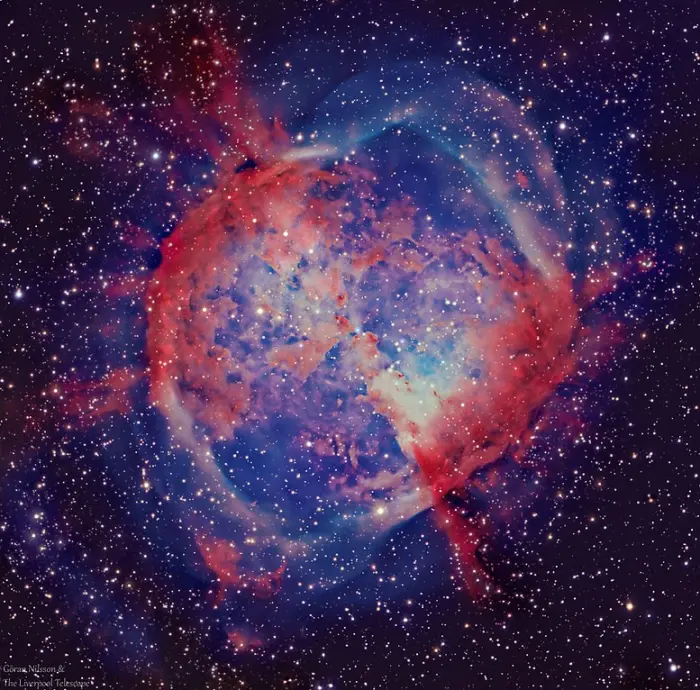
HaRGB image of The Dumbbell Nebula (M27). Data from the Liverpool Telescope (a 2 m RC telescope on La Palma) processed by Göran Nilsson. Image credit: Göran Nilsson & The Liverpool Telescope (CC BY-SA 4.0)
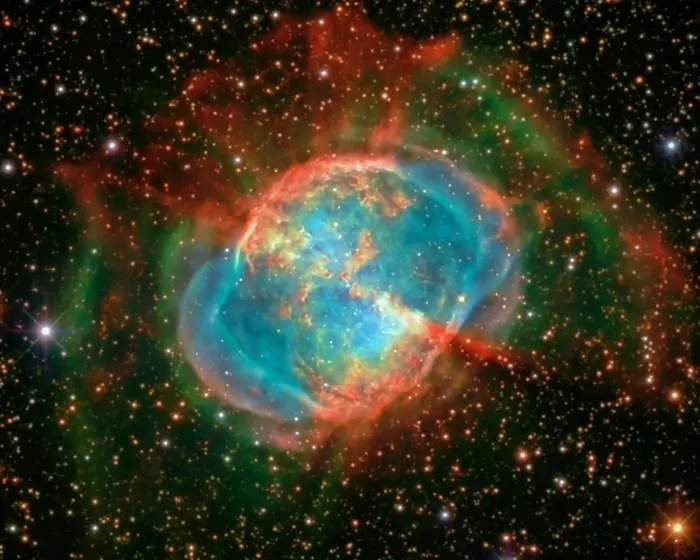
The Dumbbell Nebula, image credit: Claudio Bottari, Paolo Demaria, Giuseppe Donatiello, Marco Favuzzi, Federico Lavarino, Rolando Ligustri (CAST), Andrea Pistocchini, Bert Scheuneman, Tim Stone, Rubes Turchetti (CAST) (CC0 1.0)